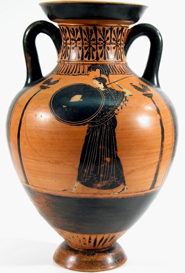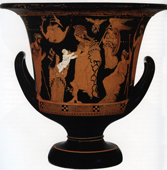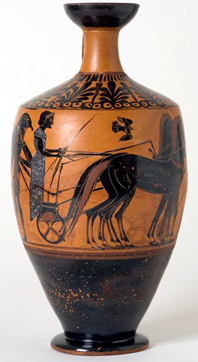W&M hosts international conference on ancient Athenian pottery
{{youtube:medium:left|hcUkpc81164}}
The images of people, gods, animals and everyday objects found on ancient Greek pottery are the single most important source for classical archeologists such as John Oakley.
For these scenes of myths and everyday life are what scholars study to better understand what life was like some 2,500 years ago.
This fall, the College of William & Mary is hosting a grandiose international conference on Greek art and archeology, entitled “Athenian Potters and Painters III,” Sept 11 – 14. It is the first time that more than 75 scholars from around the world are gathering on U.S. soil to investigate topics about this subject, such as excavation pottery, ancient pottery workshops, iconography, painters and potters, export and trade, shapes, theory, chronology and the influence of Athenian pottery on vases from other regions. Prior to coming to America, the conference was twice held in Athens, Greece, where the pottery was originally made.

Leading this massive charge is Chancellor Professor and Forrest D. Murden, Jr., Professor of Classical Studies John Oakley. He’s a specialist in Greek vase painting, iconography and Roman sarcophagi.
“I’ve always wanted to do a conference here on the William & Mary campus,” said Oakley. After receiving a $10,000 Plumeri Award in 2011, Oakley decided to take his newly earned bounty and invest it purely on Athenian pottery and addressing the key aspects of its study.
“I wanted to return to the College what had been given to me,” said the 33-year veteran professor.
The four-day conference kicks off at 5:30 p.m. with opening
remarks by Oakley, along with Provost Michael R. Halleran and Vice Provost for
International Affairs and Director of the Reves Center for International
Studies Stephen Hanson. The keynote lecture by Joan R. Mertens, curator,
department of Greek and Roman art at the Metropolitan Museum of Art in New York,
begins at 6:00 p.m. and is open to the public. Mertens is the author of “How to Read Greek Vases” (2011), and will lead
a discussion on “Chariots in Attic Black-figure Vase painting: Antecedents and
Ramifications.”

Guest speakers hail from universities and agencies across the globe, including Princeton, Oxford, the German Archaeological Institute in Athens, and the Museum of Fine Arts in Boston. A complete list can be found on the conference website.
Oakley said for 20 years he’s dreamed of walking into the College’s Muscarelle Museum of Art and seeing Greek antiquities on display. It’s the type of exhibition that’s never been done here before, until now.
In conjunction with the conference, a special exhibition of 37 Greek vases will be on display at the Muscarelle, beginning August 18 through September 30. The collection showcases the development of Athenian pottery, beginning with the patterned decoration of a Geometric Amphora (ca. 720-700 BC) and ending with the later red-figure decoration on an Attic Red-figure Calyx-krater by the Nikias Painter (ca. 410 BC). The vases are on loan from private collections in Virginia, the Virginia Museum of Fine Arts and the Chrysler Museum of Art.
Athenian pottery has been found from Asia Minor in the East all the way to Spain in the West, and was distributed throughout the Mediterranean particularly in the 6th, 5th and 4th centuries BC.

“In archeology, the one thing that is always left is pottery,” said Oakley. “It’s like I tell my students – you can kick it, drop it, spit on it, and beat it, but you still have it.”
The black-and-red-figure techniques were used by the Athenians to decorate their fine ware. The same firing process involving three stages, said Oakley, was used for both the black-figure and red-figured vases.
Mythical scenes, stories of gods and heroes, and scenes from everyday life are shown on the vases. Even courtship scenes using animals, such as roosters and hares are depicted for animals were traditional love gifts exchanged between both Athenian men and women.
“The subject of this conference and exhibition is very rich,” said Oakley.
Given the College’s status as second-oldest in the nation, Oakley can’t think of a better place to discuss and view Athenian pottery.
“We’re showing old stuff in an old place,” he said.
 Skip to main content
Skip to main content
